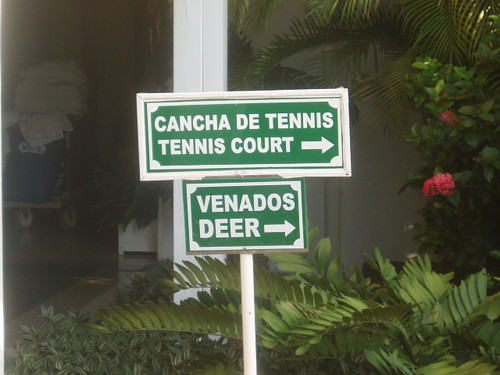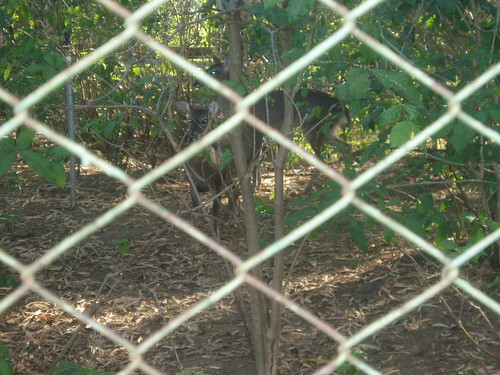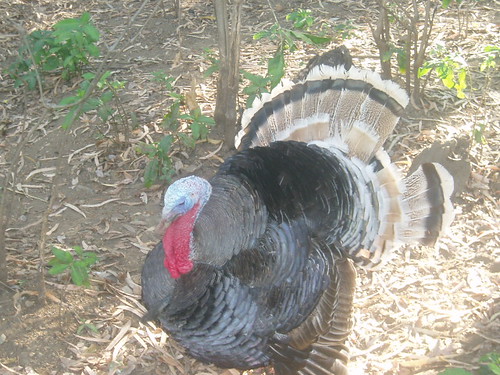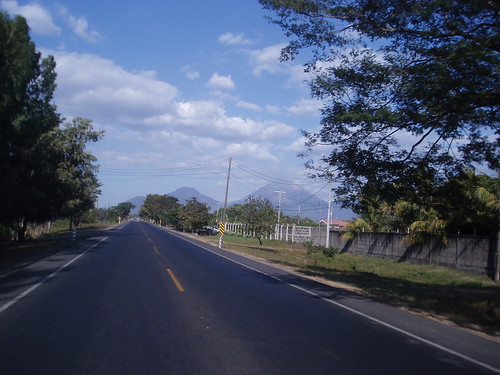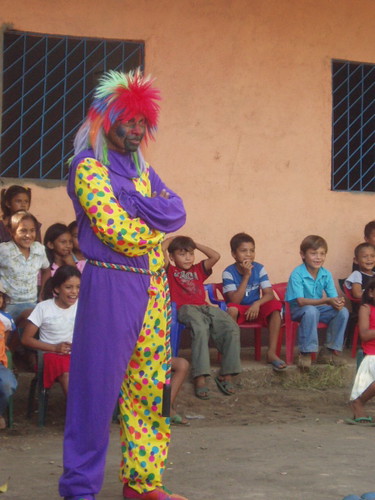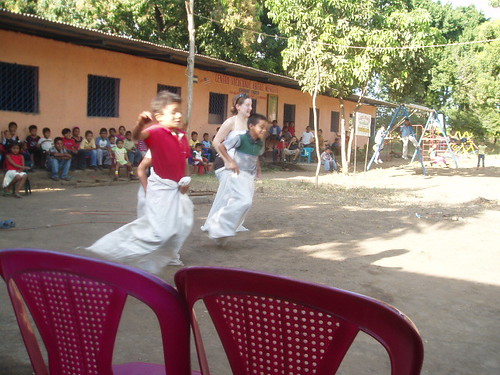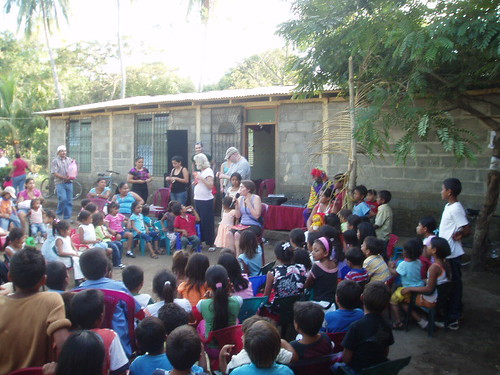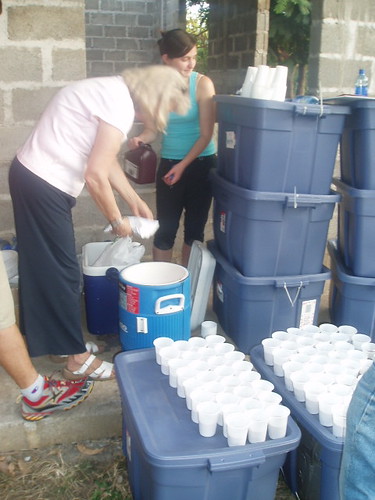I choo-choo-choose Chinandega part deux
Originally posted on the Simmons GSLIS Dispatches from the Field
Day 3, aka January 6, 2009
Our day started off bright and early in Chinandega with a walk around town before we headed out to the visit a site on our way back to Managua. We had heard that there were two crocodiles in a park, but our waiter told us that they had been deemed too dangerous for children (uh…yeah?) and were no longer there. It turned out to be a great morning for a wander about town, despite the lack of reptile watching opportunities. We somehow wound up timing our early bird stroll perfectly to run into a group of tourists of a certain early bird age, who may or may not have been on a bus tour from a cruise ship. I think our lady-bunch got the best end of the deal, as we were treated to a show of traditional dances, and had the freedom to wander around the town of our own accord.
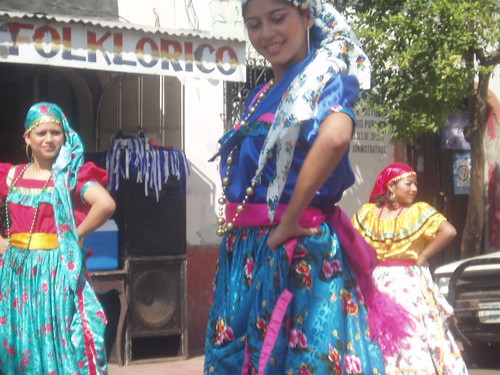
Oh snap, free show!

Folk dancers in Ameya
After observing many a Nicaraguan woman wearing some super-stylin’ aprons, I decided that I, too, needed one, and managed to find a beaut of an apron in a little store on the same street as the folk dance.
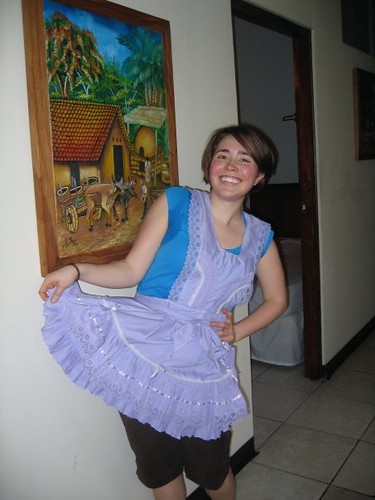
Don’t hate the player…
I’m super pleased with my purchase, even if I have a sneaking suspicion that the store owner may have sold me his wife’s favorite apron while she was out (or something). It comes with ruffles, three pockets, ribbons, and looks even more stylin’ in person. It was only $10, but will bring me ten years of joy. It’s okay that you’re all jealous; this piece is priceless.
We headed out to the local library in Chinandega, which is a Wisconsin/Nicaragua partner library run by Dona Malva, a former school teacher (I think that was her story). The Chinandega library was interesting, and our hosts were very gracious and proud of their library. I don’t want to judge it unfairly, since we were there on a day the it is usually closed on and to boot, during a vacation. I noticed that the collection was different from what I saw in other places; some books looked like they’d never been touched, others appeared out of date, and others were clearly a little too well loved, and most seemed to be nonfiction books. I read Cordoroy for the second time to an audience of middle school aged boys, which was a little different. It did seem like they had never really been to the library before; Dona Malva didn’t know their names. I found it kind of telling that when we left, the boys all surrounded the van not to say goodbye, but to ask for money, a striking difference from the other sites.
However, I was super impressed that the boys were attentive and polite; my guess is that the average pack of 12 year old American boys would have written me off on around page one of a picture book. It was clear that Dona Malva and co had put a lot of work into getting things set up “just so,” for the visit though, and I’m trying to keep this in mind when I think about the library. When does a youth library EVER have the books lined up perfectly? Ummm…NEVER. Spooky. The library building also doubles as a place where women can go to learn how to sew using machines, which was kind of cool, except we were interrupted before finding out more about the lessons (cost, materials, etc.), so I don’t know if it is a community service or what. In general, it was a solid visit, with good people who may just be a bit too focused on collection development over community need. And, retrospectively, I’m sure the Chinandega staff were nervous about impressing us and the SJDS staffers, which probably didn’t give us an entirely accurate view of how things actually are there. However, in awesome news, Jeremy now has a pack of Nicaraguan teenage fangirls with headquarters in Chinandega. How do you say “Tiger Beat Magazine” in Spanish?
Pictures from Chinandega:
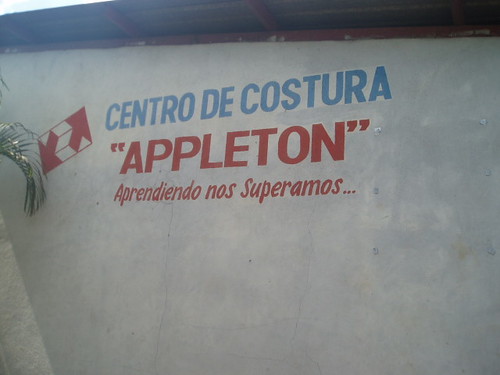
Chinandega Library
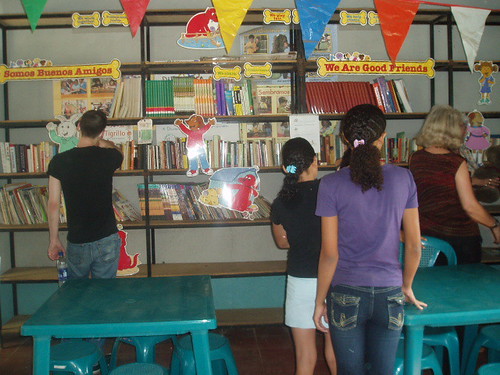
Inside the Chinandega library
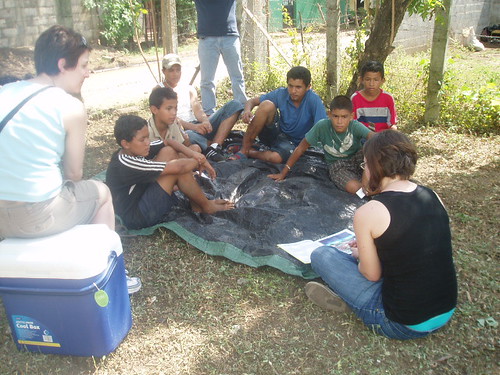
Chinandega storytime
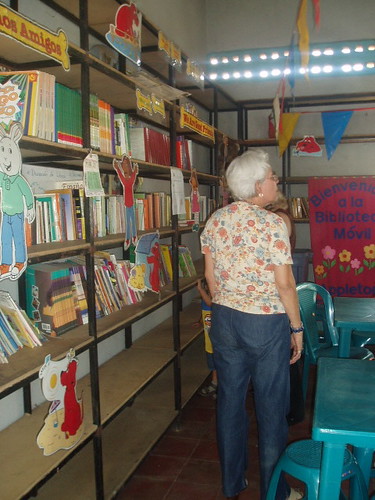
Dona Malva
Originally posted on the Simmons GSLIS Dispatches from the Field
Day 3, aka January 6, 2009
Our day started off bright and early in Chinandega with a walk around town before we headed out to the visit a site on our way back to Managua. We had heard that there were two crocodiles in a park, but our waiter told us that they had been deemed too dangerous for children (uh…yeah?) and were no longer there. It turned out to be a great morning for a wander about town, despite the lack of reptile watching opportunities. We somehow wound up timing our early bird stroll perfectly to run into a group of tourists of a certain early bird age, who may or may not have been on a bus tour from a cruise ship. I think our lady-bunch got the best end of the deal, as we were treated to a show of traditional dances, and had the freedom to wander around the town of our own accord.

Oh snap, free show!

Folk dancers in Ameya
After observing many a Nicaraguan woman wearing some super-stylin’ aprons, I decided that I, too, needed one, and managed to find a beaut of an apron in a little store on the same street as the folk dance.

Don’t hate the player…
I’m super pleased with my purchase, even if I have a sneaking suspicion that the store owner may have sold me his wife’s favorite apron while she was out (or something). It comes with ruffles, three pockets, ribbons, and looks even more stylin’ in person. It was only $10, but will bring me ten years of joy. It’s okay that you’re all jealous; this piece is priceless.
We headed out to the local library in Chinandega, which is a Wisconsin/Nicaragua partner library run by Dona Malva, a former school teacher (I think that was her story). The Chinandega library was interesting, and our hosts were very gracious and proud of their library. I don’t want to judge it unfairly, since we were there on a day the it is usually closed on and to boot, during a vacation. I noticed that the collection was different from what I saw in other places; some books looked like they’d never been touched, others appeared out of date, and others were clearly a little too well loved, and most seemed to be nonfiction books. I read Cordoroy for the second time to an audience of middle school aged boys, which was a little different. It did seem like they had never really been to the library before; Dona Malva didn’t know their names. I found it kind of telling that when we left, the boys all surrounded the van not to say goodbye, but to ask for money, a striking difference from the other sites.
However, I was super impressed that the boys were attentive and polite; my guess is that the average pack of 12 year old American boys would have written me off on around page one of a picture book. It was clear that Dona Malva and co had put a lot of work into getting things set up “just so,” for the visit though, and I’m trying to keep this in mind when I think about the library. When does a youth library EVER have the books lined up perfectly? Ummm…NEVER. Spooky. The library building also doubles as a place where women can go to learn how to sew using machines, which was kind of cool, except we were interrupted before finding out more about the lessons (cost, materials, etc.), so I don’t know if it is a community service or what. In general, it was a solid visit, with good people who may just be a bit too focused on collection development over community need. And, retrospectively, I’m sure the Chinandega staff were nervous about impressing us and the SJDS staffers, which probably didn’t give us an entirely accurate view of how things actually are there. However, in awesome news, Jeremy now has a pack of Nicaraguan teenage fangirls with headquarters in Chinandega. How do you say “Tiger Beat Magazine” in Spanish?
Pictures from Chinandega:

Chinandega Library

Inside the Chinandega library

Chinandega storytime

Dona Malva
